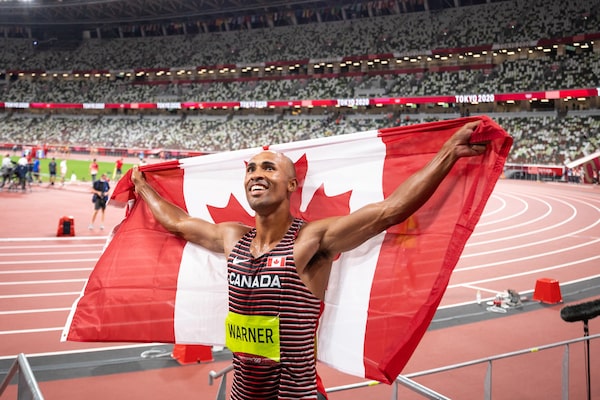As a photojournalist during the COVID-19 pandemic I’ve been wondering how people in 100 years will look back at this time. I’d love to know if someone will search whatever version of the internet they have in 2121 to find old-timey photographs of sweaty athletes, smiling behind a mask, holding Olympic medals.
The lasting story out of these Tokyo Olympics is how COVID-19 upended the world’s biggest sporting event, with silent stadiums (except for the cicadas) and mask protocols. And while the pandemic touches everything, from my perspective as a photographer the lasting moments from the Games are still dominated by the joy (and surprise) at winning a gold medal, the anguish at placing fourth, and the power of some of the world’s strongest and fastest athletes in the world.
Melissa Tait/The Globe and Mail
Canadian women won the majority of Canada’s medals in Tokyo and the swimmers topped the list with six of the 24 medals. Penny Oleksiak helps teammate Kylie Masse put on her swim cap during training at the Tokyo Aquatics Centre on the day of the opening ceremony. July 23.
Melissa Tait/The Globe and Mail
Just outside Shiokaze Park, the beach volleyball venue, is a view of the Olympic rings and the Rainbow Bridge in Tokyo Bay. This is one of very few Olympic-themed decorations that dot Tokyo. The COVID-19 restrictions blocked the public from areas inside and around the Olympic venues. July 29.
Melissa Tait/The Globe and Mail
When Maggie Mac Neil won Canada’s first gold medal of the Games everyone watching knew long before she did. Ms. Mac Neil squinted at the results for what seemed like ages before she realized she had won gold in the women’s 100-metre butterfly. July 26.
Melissa Tait/The Globe and Mail
Jessica Klimkait was a favourite for gold in women’s judo under-57-kilogram class, but she was penalized in the semi-final bout against Sarah-Léonie Cysique of France. That led to a bronze-medal match against Kaja Kajzer of Slovenia, in which Ms. Klimkait won the bronze less than an hour after her penalty. July 26.
Melissa Tait/The Globe and Mail
Rosie MacLennan was a heavy gold-medal favourite, having won gold in trampoline gymnastics at both London 2012 and Rio 2016. In Tokyo she placed a painful fourth. There were a few brief moments of tears before she left Ariake Gymnastics Centre. It was revealed afterward that Ms. MacLennan had severely injured her ankle two months earlier. It was bandaged during the Tokyo competition. July 30.
Melissa Tait/The Globe and Mail
Tokyo Olympic Stadium was empty during the Olympics. Because of pandemic restrictions, spectators were banned. Organizers set up the starting blocks a half hour ahead of the first heats in the 100-metre event. July 31.
Melissa Tait/The Globe and Mail
Andre de Grasse was already a popular draw coming into these Games, and after winning gold in the 200-metre, bronze in the 100-metre and a bronze in the 4x100-metre, he’s near the top of the list of most decorated Canadian Olympians. He cruised to victory in his first heat on July 31.

Melissa Tait/The Globe and Mail
After winning bronze in the decathlon in Rio 2016, Damian Warner of Canada celebrates as he improves to gold in Tokyo. He is only the fourth man to surpass 9,000 points and the first to do it in an Olympic Games. Aug. 5.
Melissa Tait/The Globe and Mail
Canada’s Christine Sinclair played international soccer for 21 years, scoring 187 international goals, before finally winning a gold medal at the Tokyo Olympics. She congratulated Julia Grosso, who scored the winning penalty kick against Sweden. The Canadian women won the first soccer gold medal for Canada, beating Sweden in a penalty shootout (after defeating long-time rival United States in the semi-final 1-0). The final was watched by 4.4 million people in Canada on a weekday morning – clearly a defining moment of the Tokyo Olympics. Aug. 6.
Melissa Tait/The Globe and Mail
The Tokyo Olympics carried on without spectators, but continued as though fans were still in the building. Before events there were light shows, video displays, encouragements for the crowd to cheer, even dance shows at the gymnastics venue and a DJ at beach volleyball. All of this was in front of empty seats, except for staff, media and athletes. July 26.

Melissa Tait/The Globe and Mail
Crowds of people outside the Olympic Stadium during the closing ceremonies of the Tokyo Olympics. Police kept the crowds packed into the sidewalk across from the stadium, there was a a protest, but the majority of onlookers were filming for fireworks. Spectators were banned throughout the Olympics due to the COVID-19 pandemic, including Japanese spectators just prior to the opening of the Games. Aug. 8.